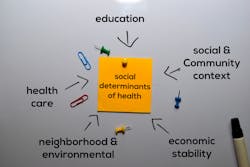Part of Humana Health Plan’s population health initiative involves developing and supporting multi-sector partnerships to address issues such as food insecurity. Researchers are studying the community-level effects of this initiative using data from a national, longitudinal survey of community health networks collected during 2012-2018.
Systems for Action is a research program of the Robert Wood Johnson Foundation that is testing new ways of connecting the nation’s fragmented medical, social, and public health systems. During a Sept. 15 webinar, Humana executives joined Glen Mays, Ph.D., director of the Systems for Action program, to discuss Humana’s “Bold Goal” Initiative and the research conducted to assess its potential impact.
Jessica Dobbins, Dr.PH., associate director of Humana’s Office of Health Affairs and Advocacy, noted that there is a growing body of research that demonstrates that networks of community organizations can have significant effects on health trajectories and that health and social interventions are more likely to succeed through strong and connected multisector networks.
In 2015, Humana launched its Bold Goal Initiative, a population health strategy focused on addressing social determinants and the health-related social needs of its members and communities.
Stephanie Franklin, Humana’s senior population health strategy professional for the Bold Goal program, says the program is using the Healthy Days measure developed by the CDC to measure health-related quality of life. Healthy Days is self-reported and focuses on holistic factors in both physical and mental health.
“We started off by hiring a population health lead for each community, someone employed by Humana, who can create those relationships in the community with different stakeholders,” Franklin said. “As we looked at how we make it easier for everyone to achieve their best health, it really drew us to these upstream barriers to health because we know that we can't improve our members’ health outcomes unless we're addressing the context in which they live, work, and play. The heart of our Bold Goal strategy is addressing social determinants of health and health-related social needs through a lot of different levers.”
She said they have developed community partnerships to screen members for their health-related social needs, connect them to community resources, establish benefits, and try to bolster the social care infrastructure of the communities they serve. “We do acknowledge that each community is very different. They have unique barriers; they have huge needs. And that's really been the focus of our population health needs, and the strategies and the collaborations that we formed at the community level.”
Dobbins said one example is a program they’ve launched in Jacksonville, Fla., including the University of North Florida, and local hospitals in an effort to support food security among homebound older adults in Northeast Florida. “This collaborative program recovers food from local hospitals — food that would normally be wasted or thrown away. We've repackaged that food into really beautiful healthy meals,” she said. The meals are delivered by University of North Florida students to older adults who have been on the waiting list for meals on wheels. “It is a perfect example of these types of multisector partnerships that we're seeking that really aim to improve population health,” she added.
Mays, the chair and a professor in the Department of Health Systems, Management & Policy in the Colorado School of Public Health at CU Anschutz, discussed some of the research on the impact of Bold Goal.
It found that there was a 10 percent increase in the density of the networks — how many organizations are working together on population health. “The impact was sizeable and significant by 2018,” Mays said. “We saw denser networks, but they were not more centralized.” A third of the sectors increased their participation, including hospitals. Employers, faith-based organizations and schools increased participation by 10 to 15 percent.
The Bold Goal appears to have a sizable impact on the overall size of the network collaborating on these activities and also has significant effects in terms of increasing participation in networks by a number of key sectors, including hospitals, physicians, health insurers, but also employers and faith-based organizations and schools, he added.
The researchers use the effects of Bold Goal on network structure to estimate potential longer-term effects on health and economic outcomes and metrics over a 10-year timeframe.
“This analysis is based on earlier work that we've published showing that communities that increase the strength of their networks over time — those communities over 10 years see significant reductions in preventable mortality rates in the community,” Mays said. These are deaths before age 75 from preventable conditions.
Communities that strengthen their networks over time also see reductions in Medicare spending per person over time, he said. If the short-term network changes they saw were maintained over 10 years, the researchers project that would result in about a 5 percent reduction in preventable mortality in these vulnerable communities, compared to a comparison group, and a little over a 6 percent reduction in Medicare spending per person in the Bold Goal communities over 10 years.
Dobbins said that one key to success is sustaining the strength of the network density, participation and coordination. “This can be quite challenging, and we know this firsthand based on the work that we've done in our vulnerable communities,” she said. “We know that Humana is not the hub or driver in these networks, and we think that is what allows them to be sustainable. Network participation in our Bold Goal communities is generally more distributed across our partners.”
She said that in order for these multisector partnerships to sustain, they need to evolve. “The food repurposing program in Jacksonville that I mentioned earlier, in order for it to sustain it had to evolve and grow and change,” Dobbins said. “The University of North Florida started to introduce new partners into the program; they started to bring in additional food sources, not just looking at hospitals, but looking at other opportunities to pull in and repurposed food; they brought in new client populations, and in the future plan to develop a toolkit to replicate the program in other universities. Sustainability is a big part of this story.”


